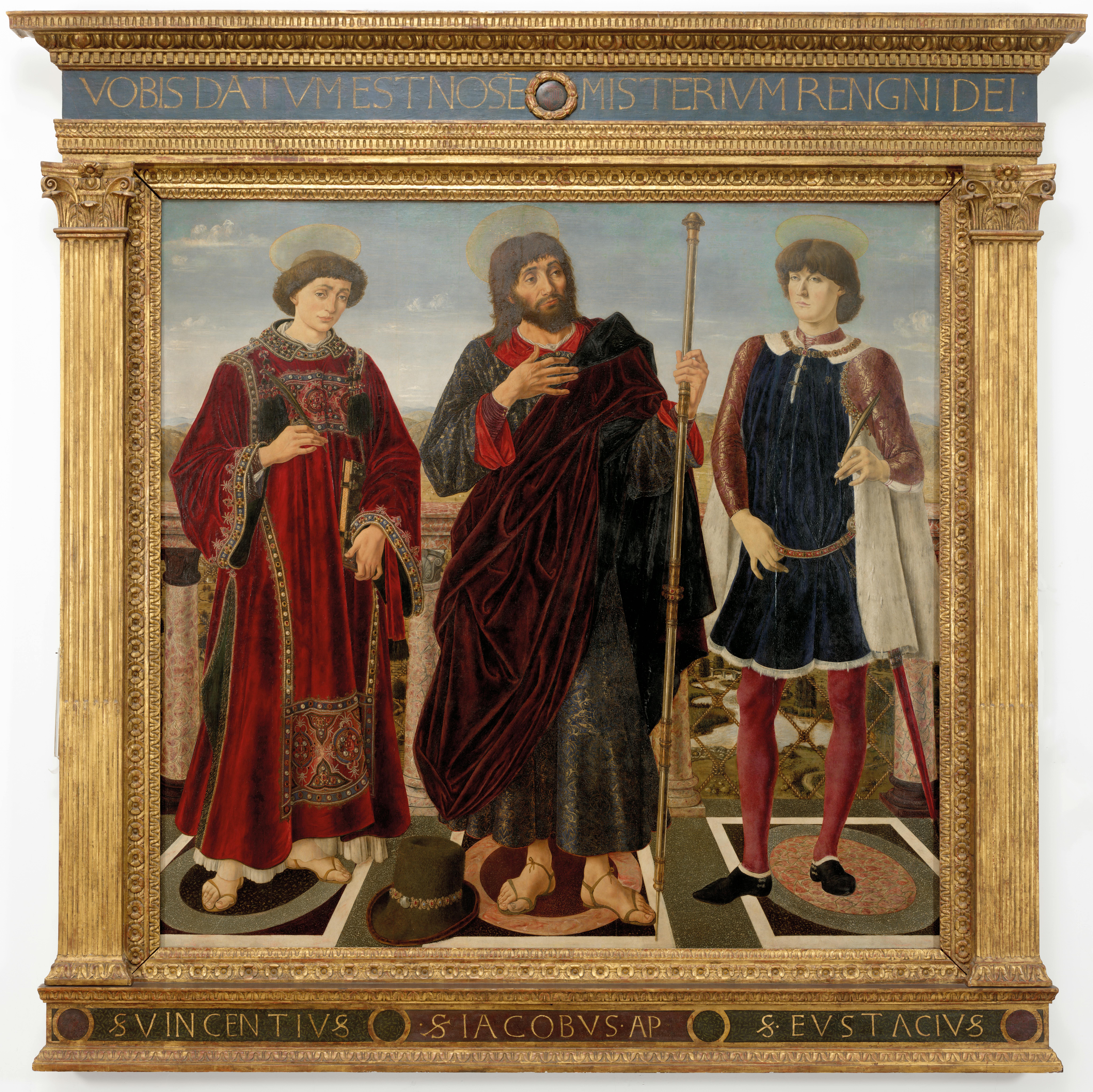Saints Vincent, James the Great, and Eustace
Antonio del Pollaiolo (Florence 1431- Rome 1498) and Piero del Pollaiolo (Florence 1441- Rome 1496)
S. VINCENTIUS; S. IACOBUS AP; S. EUSTACIUS (in the frame, bottom); VOBIS DATUM EST NOSSE MISTERIUM RENGNI DEI (in the frame, top)
Three saints are depicted in front of a vast landscape; among them, Apostle James the Great is portrayed in a prominent position in the center foreground. His staff and the hat at his feet, which is adorned with a shell, are attributes of the pilgrims who used to travel to Santiago de Compostela in Galicia to visit the relics of the apostle.
On the left, deacon Vincent is depicted while holding the book of the Holy Scriptures and the palm of martyrdom, whose remains are in Lisbon, the Portuguese capital, of which he is the patron saint. The last figure is martyr Eustace, who is portrayed as an elegant man of arms, with his sword strapped to his side, thus referring to the tradition according to which he was a valiant Roman commander before converting to Christianity. In the frame, at the bottom, the names of the saints identify each character, while at the top is transcribed a passage from the Gospel of Mark 4:11 "Unto you it is given to know the mystery of the kingdom of God". The inscription is interrupted by a brass roundel inserted in a garland, on which is reproduced the coat of arms of Cardinal James of Lusitania, who was a member of the Portuguese royal family and bishop of Lisbon. He was cardinal deacon of the church of Saint Eustace in Rome and died in Florence in 1459, at the age of twenty-five, while he was travelling to Mantua. For his burial, a chapel was built and decorated in the Florentine church of San Miniato al Monte, with the participation of some of the greatest artists of the time, who together created a true Renaissance treasure chest, that is still preserved today. The altarpiece was commissioned to the brothers Antonio and Piero del Pollaiolo. Despite setting the sacred representation in a landscape, they decided to place the figures on a sort of balcony with a precious marble floor and a balustrade composed of columns alternated with metal gratings, thus reproducing the richness and variety of materials used for the decoration of the chapel. The image expresses opulence, the light caresses the precious robes of silk and velvet, and the garments are enriched with precious stones and jewels, including the pilgrim's hat of the Apostle James, whose staff looks like precious jewellery. The rendering of these details is meticulous, and is the result of the influence of Flemish painting, which is also visible in the distant view of the landscape, as well as in certain technical aspects, such as the choice of oil paint and the use of oak wood for the construction of the support.
The panel is completed by the splendid carved and gilded wooden frame, made by Giuliano da Maiano (Maiano, Florence 1432-Naples 1490). In order to be better preserved, the altarpiece was removed from the church of San Miniato and taken to the Uffizi in 1800.
A. Wright, The Pollaiolo brothers. The arts of Florence and Rome, New Haven 2005, pp. 192-204;A. Galli, I Pollaiolo, Milano 2005, pp. 22-23; A. Tartuferi in La stanza dei Pollaiolo. I restauri, una mostra, un nuovo ordinamento, a cura di A. Natali e A. Tartuferi, Firenze 2007, pp. 92-97
